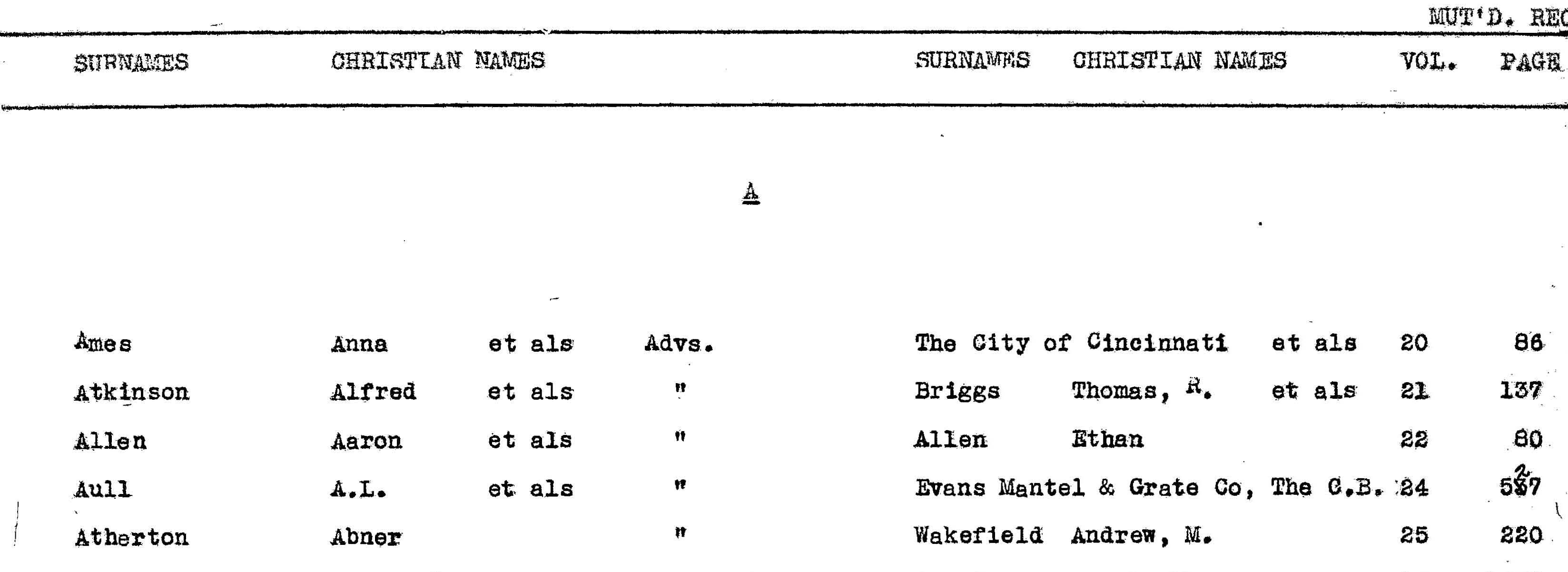Hamilton County, Ohio, Historic Courts
Common Pleas Court 1802 to 1884
The Court of Common Pleas began in England and was transplanted to colonial America. The 1788 territorial act brought the court to Ohio territory, to be composed of from 3 to 5 members, who were to be appointed by the territorial governor and to have jurisdiction in all civil matters. These courts continued with the 1802 Ohio constitution, to have a president and associate judges. The members of the court, appointed by joint ballot of both houses of the general assembly, were to be held in three judicial districts.
Since the constitution required legislative action, such an act was passed in 1803. This act gave the Court of Common Pleas original jurisdiction (responsibility) in all cases in law and equity when the matter in dispute exceeded the jurisdiction of justices of the peace. The court had original jurisdiction of all probate, testamentary (will bequests and appointments) and guardianship of orphans and minors.
It was also given all criminal matters that exceeded the jurisdiction of justices of the peace, except for capital cases. Also, more complex cases such as equity normally held in a chancery court. Adjustments to chancery cases, that is, cases involving remedies other than monetary damages, such as injunctions, writs, or specific performance were made in 1804, 1807 and 1824. In 1843, jurisdiction of divorce and alimony cases were given concurrently to the Court of Common Pleas and the Ohio Supreme Court.
The Court of Common Pleas and the Ohio Supreme Court were both assigned original cognizance (the right to deal with a legal case in the court system; jurisdiction; responsibility) of criminal cases as provided by law. Appeals in civil cases might be made from county commissioners, justices of the peace and other courts inferior to the Court of Common pleas. The court was authorized to appoint a clerk.
The new Ohio constitution of 1852 created a separate court for probate, testamentary and guardianship matters thereby removing such matters from the Court of Common Pleas. However, judgments and final decrees of the Probate Court could be “reversed, vacated, or modified” by error proceedings in the Court of Common Pleas. If the case involved real estate, many of these records were copied into deed books which can be seen in the Recorder’s Office.
In 1852, the Court of Common Pleas was given exclusive jurisdiction in divorce cases. At this time, the Court of Common Pleas was also given original jurisdiction of all crimes and offenses, except for minor criminal cases that were invested in the justices of the peace or other minor courts.
But shortly thereafter, the Criminal Court of Hamilton County was re-established with the transfer of jurisdiction of criminal cases from the Court of Common Pleas which remained in jurisdiction of civil matters. The Superior Court of Cincinnati was also re-established. Except for divorce, alimony, and bastardy, the Superior Courts had the same jurisdiction as the Court of Common Pleas in civil cases. This can be seen in cases involving land as recorded in the deed books in the Recorder’s Office.
After the Courthouse fire on March 31, 1884, those Common Pleas court records that survived were copied into 45 books of reconstructed cases, approximately 25,000 pages. Two indexes were created, one for the first 19 books and a second for books 20 through 45. For ease of use, the indexes have been separated into 26 files by first letter of the litigants’ surname, then by first letter of the first name. In the index example below, the center column has the abbreviation vs. (versus) or Advs. (sued by).
Anna Ames et als (and others) are the defendants and City of Cincinnati et als are the plaintiffs suing Anna Ames. (plaintiff: a person who brings a case against another in a court of law). The entries for this case that has survived are in book 20 on page 86.

Businesses or partnership suits are in the last page of each letter index. If the business is known as say “A. B. Smith & sons” it will be listed under S. You only need to look in the left-hand column as both Plaintiff and Defendant for every case will be in the left column.
After finding your case number located within the name indexes, to obtain copies from the reconstructed case books, please send an email to Jason Alexander at JAlexand@cms.hamilton-co.org stating the litigants’ names and the book number and page number stating that it is from a reconstructed common pleas book before 1884 and that you are seeking any additional documents that we may have on file regarding this case.
Books 1 thru 19 index A B C D E F G H I J K L M N O P Q R S T U V W XYZ
Books 20 thru 45 index A B C D E F G H I J K L M N O P Q R S T U V W XYZ
Sources: Inventory of the County Archives of Ohio 31 Hamilton County (Cincinnati), WPA, CD 3447.A1 H55 1937 no.31





